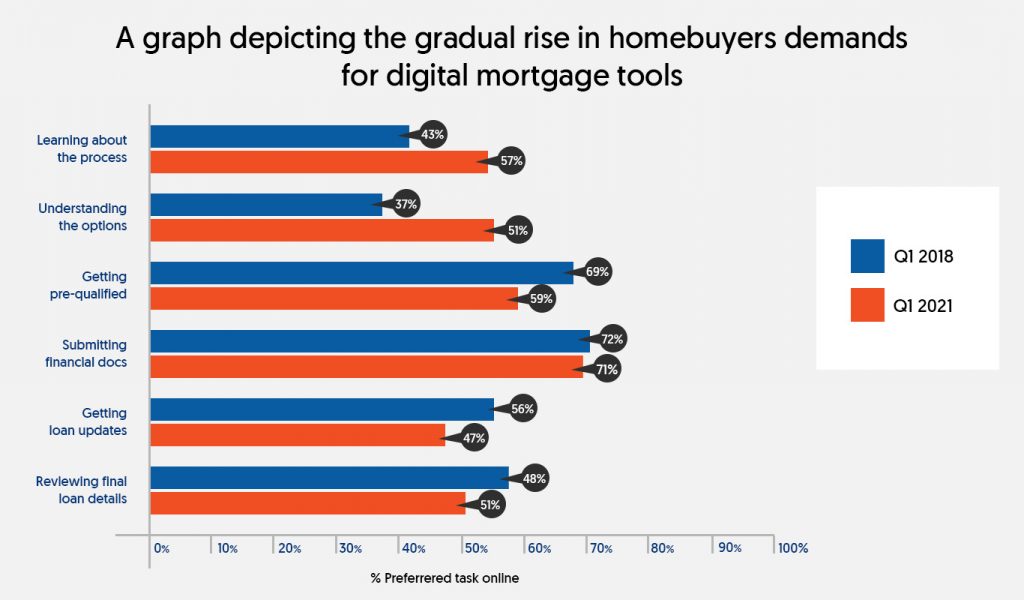In a post-pandemic new year, the mortgage market is expected to witness gradual growth in the number of homebuyers, listing prices, rents, and lending rates. It would be a busy year ahead for lenders as more sellers would enter the market to meet growing buyer needs. But the opportunities will also set a new bar for operational resilience, forcing lenders to step up, evaluate, and fine-tune their workflows to meet market demands.
Significant Mortgage Trends for 2022 and Action Items for Lenders
A Rapid Surge in Foreclosures
As most pandemic-related mortgage bailouts are ending soon, foreclosures are picking up pace. With the eventual end of the forbearance protection earlier set by the CARES Act, lenders are expected to save borrowers from qualifying as loan defaulters. They need a detailed working structure and resources to help homeowners nearing the end of their loan payment moratorium. For foreclosures, they must conduct foreclosure auctions on abandoned properties and work with borrowers to carve a payment plan with adjusted loan terms.
For efficient foreclosures, lenders must discard their archaic workflow setup and pursue a digitized ecosystem to handle foreclosure documents, identify and rectify the errors, and prepare the end result in a client-specified format. For lenders with resource shortages, it’s high time they delegated all foreclosure back-end jobs to trustworthy mortgage BPOs whose committed foreclosure experts would manage the entire process and ensure optimum outcomes for their clients.
| In the third quarter of 2021, mortgage lenders initiated foreclosures on 25,209 properties, which was 32% more than the numbers in the second quarter of the year. On a YOY basis, it’s a massive 67% rise from the third quarter of 2020. |
The Regulatory Environment Beefed Up
In 2022, the industry would be subjected to additional scrutiny from the regulators, especially the CFPB. This has already spurred lenders into action as the CFPB is expected to take up a ‘watchdog’ role with enforcement rules not seen in the past. Lenders must have renewed focus on all work areas, including foreclosure policies and customer data management. The regulatory changes expected in 2022 would probably last for years, hence most lenders would turn to mortgage outsourcing partners to better align their workflows to the regulatory environment ahead.
| Items that the CFPB will prioritize in 2022 include Fair Lending, especially redlining; RESPA; and increased enforcement of mortgage servicers, particularly the ones related to foreclosure policies. |
Regulatory changes often trouble small and midsize lenders that are mostly understaffed. It wouldn’t be easy for them to hire and train in-house compliance and vigilance teams at such short notice. For compliance and service quality, existing operational procedures must be audited with a fine-toothed comb to identify all areas of concern. Any carelessness here could have serious implications, including heavy financial penalties on the lender. It’s best for such lenders to bank on mortgage BPOs for additional checks in the diligence process and install fail-safe systems that support high-quality results while minimizing risks during QC/due diligence.
Process Quality Will Determine Lender Profitability
When the pandemic hit the mortgage industry, the frenetic pace of loan originations didn’t allow adequate time for lenders to focus on their systems and operations and make the necessary adjustments. In contrast, lenders would be forced to return to basics in 2022. The current market forces and the increasing competition are already pushing them to take a hard look at their workflows and business policies. For survival, lenders must ensure that no aspect of business has lapsed into complacency and must tighten all processes to prevent leakage.
| Cost reduction is a priority for credit unions and most bank leaders. In a survey of small and mid-size bank leaders, 55% of the participants said digitization will slash mortgage initiation costs by at least 26%. |
Mortgage leadership teams must create a detailed checklist to scrutinize and improve all aspects of operations. For instance, they must test the percentage of existing locks to check if the company is meeting its corporate margins. Preparing a stagnation report to spot bottlenecks in the loan manufacturing process would be a good start. To stay prepared for calamities, lenders must develop mechanisms to identify negative trends and build operational resilience before they start affecting profitability. Besides scrutinizing individual policies and procedures, they must focus on improvements that positively impact their bottom line. For example, introducing automation optimizes workforce efficiency enables the lending team to work on higher-value tasks.

The home finance scenario in 2022 will be different from its current state. Forecasts indicate good business for lenders as the market prepares for a strong rebound. However, mortgage businesses must ensure their preparedness to meet the market dynamics and serve prospects and clients efficiently. The key is to adopt a fool-proof operational strategy to focus on potential obstacles and strengthen their business with stronger processes, increased efficiency, and leading technology. Opting for mortgage outsourcing for digitization would be critical here as it would add value at every step of the loan manufacturing process. Besides, it would add real basis points to loans, keeping operating costs in check, and creating improved economics.
Who We Are And Why We Are An Industry Authority?
This article is brought to you by Expert Mortgage Assistance (EMA). We are a back office support providers for mortgage lending needs. As the mortgage industry prepares for better days in 2022, we are helping lenders by building strong systems that would insulate them from all future fluctuations.




